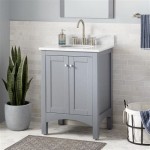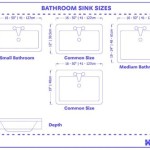Small Rectangular Undermount Bathroom Sinks: A Comprehensive Guide
The small rectangular undermount bathroom sink represents a compelling solution for bathroom design challenges, particularly in spaces with limited square footage. This style of sink offers a clean, modern aesthetic while maximizing counter space. Its undermount installation method further contributes to a seamless and uncluttered look. This article will delve into the key features, benefits, selection criteria, installation considerations, and maintenance practices associated with small rectangular undermount bathroom sinks.
Space Optimization and Design Aesthetics
The primary advantage of a small rectangular undermount sink lies in its space-saving design. Bathrooms, especially in apartments or older homes, often present spatial constraints. A rectangular shape, judiciously sized, allows for efficient utilization of the available countertop area. Unlike bulky, traditional sinks, the rectangular form factor can be integrated more seamlessly, leaving ample room for toiletries, decorative items, or other essential bathroom accessories.
Furthermore, the undermount design enhances the visual appeal of the bathroom. By being installed beneath the countertop, the sink rim is concealed, creating a smooth, uninterrupted surface. This clean line contributes to a minimalist and contemporary aesthetic, which is highly sought after in modern bathroom design. The countertop material becomes the focal point, showcasing its natural beauty and texture without obstruction.
The rectangular shape, with its sharp angles and defined lines, complements a variety of design styles, from modern and contemporary to transitional and even some minimalist applications. Choosing the right material and finish can further tailor the sink's appearance to match the overall bathroom decor. For instance, a white porcelain sink pairs well with bright, airy designs, while a darker-colored composite stone sink can add a touch of sophistication and drama.
The absence of a visible rim also simplifies cleaning. Debris and water are easily wiped directly into the sink without the hindrance of a bulky edge. This contributes to a cleaner and more hygienic bathroom environment, reducing the build-up of grime and bacteria in hard-to-reach areas.
Material Selection and Durability
Small rectangular undermount sinks are available in a diverse range of materials, each offering unique properties in terms of durability, aesthetics, and maintenance requirements. The common materials include porcelain, ceramic, cast iron, stainless steel, and composite stone.
Porcelain and ceramic sinks are popular choices due to their affordability, ease of cleaning, and resistance to stains and scratches. Porcelain is a type of ceramic that is fired at a higher temperature, resulting in a denser and more durable material. Both materials are relatively non-porous, preventing the absorption of water and bacteria. However, they are susceptible to chipping if subjected to significant impact.
Cast iron sinks, coated with a thick layer of enamel, offer exceptional durability and heat resistance. The enamel coating provides a smooth, glossy surface that is easy to clean. However, cast iron sinks are considerably heavier than other options, requiring a robust countertop and support structure. They also tend to be more expensive.
Stainless steel sinks are known for their durability, resistance to corrosion, and modern appearance. They are lightweight and relatively easy to install. However, stainless steel sinks can be prone to scratching and water spots, requiring regular cleaning to maintain their shine. The gauge of the stainless steel is an important factor to consider; a lower gauge number indicates thicker and more durable steel.
Composite stone sinks, made from a blend of natural stone particles and resin, offer a unique combination of durability and aesthetic appeal. They are available in a wide range of colors and textures, mimicking the look of natural stone at a lower cost. Composite stone sinks are generally resistant to stains, scratches, and heat. However, they may be more susceptible to damage from harsh chemicals.
The choice of material should be based on a combination of factors, including budget, desired aesthetic, durability requirements, and maintenance preferences. Considering the expected level of use and potential for abuse is crucial in selecting the most appropriate material for a small rectangular undermount bathroom sink.
Installation Considerations and Plumbing Requirements
Installing a small rectangular undermount sink requires careful planning and attention to detail. The process involves cutting an appropriately sized opening in the countertop, attaching the sink to the underside of the countertop, and connecting the plumbing fixtures. It is generally recommended that homeowners with limited plumbing experience hire a professional plumber for this task to ensure proper installation and prevent leaks.
Before installation, the countertop material and thickness must be considered. Thicker countertops may require a different type of mounting hardware than thinner countertops. The cut-out for the sink must be precise to ensure a snug and secure fit. It's critical to consult the manufacturer's specifications for the sink to determine the correct dimensions and cut-out template.
The mounting hardware typically consists of clips or brackets that are attached to the underside of the countertop using screws or adhesive. The sink is then secured to the clips, ensuring that it is level and properly aligned. Silicone sealant is applied around the rim of the sink to create a watertight seal, preventing water from seeping between the sink and the countertop.
Plumbing connections involve connecting the drainpipe to the sink's drain assembly and connecting the hot and cold water supply lines to the faucet. It is essential to use appropriate plumbing fittings and sealant to prevent leaks. The drainpipe must be properly sloped to ensure efficient drainage. The drain assembly typically includes a stopper mechanism, which allows the sink to be filled with water.
Accessibility to plumbing shut-off valves is an important consideration. These valves allow the water supply to the sink to be shut off in case of leaks or maintenance. Ensuring that the shut-off valves are easily accessible will simplify future repairs and maintenance.
The placement of the sink within the countertop layout also impacts plumbing. Consider how far from the wall the sink will be, how much space the drain requires, and where water pipes are located. Adjustments to plumbing might be necessary to accommodate the new sink location.
Furthermore, the design of the faucet should be compatible with the sink's dimensions and style. A small, minimalist faucet may be ideal for a small rectangular undermount sink, while a larger, more ornate faucet may overwhelm the space. The reach and height of the faucet should also be considered to ensure that water flows smoothly into the sink without splashing.
Maintenance and Cleaning Practices
Proper maintenance and cleaning are essential to prolong the life and maintain the appearance of a small rectangular undermount bathroom sink. The frequency and type of cleaning required will depend on the material of the sink and the frequency of use.
For porcelain and ceramic sinks, regular cleaning with a mild soap and water solution is usually sufficient. Avoid using abrasive cleaners or scouring pads, as they can scratch the surface. Stubborn stains can be removed with a gentle stain remover specifically designed for porcelain or ceramic surfaces.
Cast iron sinks with enamel coatings should be cleaned with a non-abrasive cleaner and a soft cloth. Avoid using harsh chemicals or abrasive cleaners, as they can damage the enamel coating. To prevent rust, dry the sink thoroughly after each use.
Stainless steel sinks require regular cleaning to prevent water spots and fingerprints. Use a stainless steel cleaner and a soft cloth to polish the surface. Avoid using abrasive cleaners or steel wool, as they can scratch the surface. Rinse the sink thoroughly and dry it with a clean cloth to prevent water spots.
Composite stone sinks can be cleaned with a mild soap and water solution. Avoid using harsh chemicals or abrasive cleaners, as they can damage the surface. Wipe up spills promptly to prevent staining. Periodic sealing may be required to maintain the sink's stain resistance.
In addition to regular cleaning, it is important to flush the drain regularly to prevent clogs. Pouring hot water down the drain periodically can help to dissolve grease and debris. If a clog does occur, use a plunger or drain cleaner to clear the blockage.
Preventative measures also minimize maintenance. Avoid pouring harsh chemicals or corrosive substances down the drain, as they can damage the plumbing system. Place a strainer in the drain to catch hair and other debris, preventing them from clogging the drainpipe. Wipe up spills and splashes promptly to prevent staining and water damage.
By adopting these maintenance and cleaning practices, homeowners can ensure that their small rectangular undermount bathroom sink maintains its beauty and functionality for years to come.

B606 Rectangular Undermount Vanity Sink Bristol Sinks

Kraus Elavo Small Rectangular Ceramic Undermount Bathroom Sink In White With Overflow Kcu 241 The Home Depot

Swiss Madison Voltaire 21 In Rectangular Undermount Bathroom Sink Glossy White Sm Um625 The Home Depot

Scarabeo 8091 By Nameek S Miky 22 Inch Rectangular Ceramic Undermount Sink Thebath

Pin On S

Zeek Zp 1611 Small Rectangular U M Bathroom Sink 16 X 11 Inch

Allen Roth White Undermount Rectangular Traditional Bathroom Sink 19 69 In X 15 75 At Com

Undermount Bathroom Sink Buyer S Guide The Family Handyman

Glacier Bay 21 6 In Ceramic Rectangular Undermount Bathroom Sink White With Overflow Drain Lvb1038 The Home Depot

Scarabeo 5137 By Nameek S Teorema 2 Undermount Sink Trough White Ceramic Thebath







